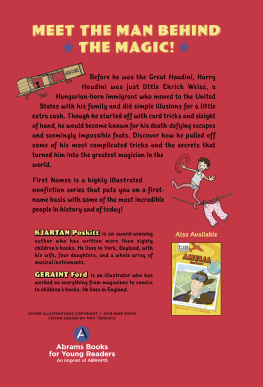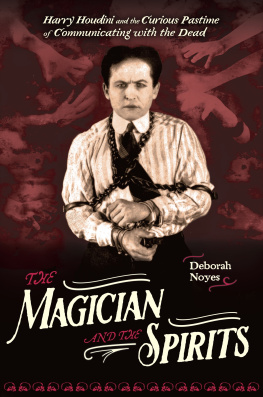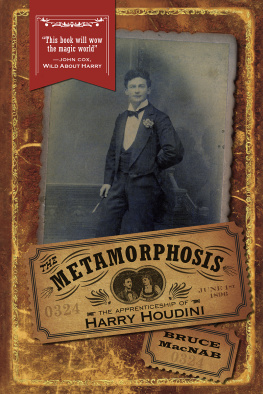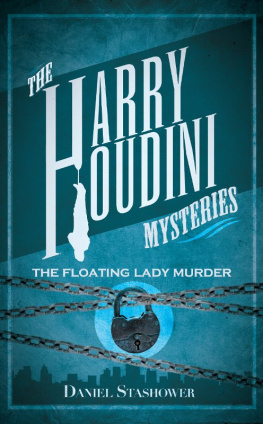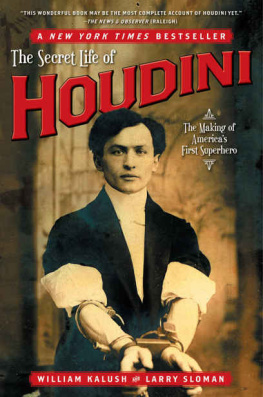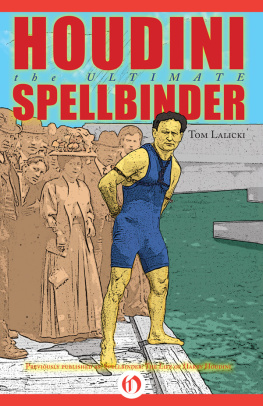

This edition is published by PICKLE PARTNERS PUBLISHINGwww.pp-publishing.com
To join our mailing list for new titles or for issues with our bookspicklepublishing@gmail.com
Or on Facebook
Text originally published in 1959 under the same title.
Pickle Partners Publishing 2016, all rights reserved. No part of this publication may be reproduced, stored in a retrieval system or transmitted by any means, electrical, mechanical or otherwise without the written permission of the copyright holder.
Publishers Note
Although in most cases we have retained the Authors original spelling and grammar to authentically reproduce the work of the Author and the original intent of such material, some additional notes and clarifications have been added for the modern readers benefit.
We have also made every effort to include all maps and illustrations of the original edition the limitations of formatting do not allow of including larger maps, we will upload as many of these maps as possible.
HOUDINI:
THE MAN WHO WALKED THROUGH WALLS
BY
WILLIAM LINDSAY GRESHAM
TABLE OF CONTENTS
Contents
BY THE SAME AUTHOR
NIGHTMARE ALLEY
LIMBO TOWER
MONSTER MIDWAY
DEDICATION
To the greatest living escape artist
The Amazing Randi
(Mr. James Randall Zwinge)
this book is dedicated with the sincere admiration of the author
AUTHORS ACKNOWLEDGMENTS
Above all, the author wishes to thank Clayton Rawson for his constant help and for making available his library of rare works on magic. While differing from the author in his opinions on exposing the tricks of the escape artist, he nevertheless assisted the research in too many ways to enumerate.
The author wishes to thank, in alphabetical order, the following:
Roy Benson, who grew up in vaudeville and magic;
Allan Bernard, old friend of Greenwich Village days, for his recollections of the late Evening Graphic ;
Milbourne Christopher, past president of the Society of American Magicians, for permission to check through his collection of five hundred Houdini letters;
Mrs. Laura Abbott Dale, research officer of the American Society for Psychical Research, for her help in recommending sources;
Joseph Dunninger for personal recollections of Houdini, as well as for his contribution of photographs from his collection and permission to go through his amazing scrapbooks;
Bruce Elliott, my long-time mentor in things magical;
Al Flosso, magician and magic dealer, old friend of Houdinis;
Martin Gardner, who contributed his entire collection of Houdini clippings;
Walter B. Gibson, authority on Houdini and escape magic from whom, years ago, I got most of the carnival material for a novel, Nightmare Alley , for memoirs of the Great Escapist;
Lewis Goldstein, last surviving member of the original Houdini company, for his many anecdotes of the Prison Defier;
Rene Gresham for moral support and secretarial help;
Dr. John Henry Grossman, physician and chemist, for his researches into fire-resisting formulas; likewise his gift of two rare pamphlets;
Marcus Henvit for his long and informative letters;
Jean Hugard, dean of magicians, for special data;
Burling Hull for information on his Escape from Flames;
Dr. Stanley Jaks for Hungarian sources on Houdinis birth;
Fred Keating for his many helpful suggestions and his charity toward an exposer of secrets;
Robert Lund for his energetic leg work on the Belle Isle Bridge mystery;
Sam Margolies for his kindly contribution of sources;
Jay Marshall for his steady friendship through troubled years and his contribution of essential rare books and pamphlets from his collection;
Michael Miller, authority on the Houdini house;
David Moffett for research on underwater burial data;
John Mulholland, one of the best-loved figures in magic, for his help over the years;
New Rochelle Public Library staff for their patience and cooperation;
George Pfisterer for his many acts of kindness and his help with disputed points in Houdini letters;
Sidney Hollis Radner for the time given me in showing his Houdini collection as well as many hours spent in fascinating experiments with handcuffs;
Robert Towner for many odd bits of information;
The late Audley Walsh for Houdini anecdotes;
Dr. Morris N. Young for his ready cooperation in providing leads to source material;
To all these and many others who have been of assistance, I wish to extend my thanks.
Inaccuracies and defects in the book are to be laid at the door of the author and not of his sources.
W. L. G.
PROLOGUETHE SHAKING TENT
IF MAN has an instinct stronger than self-preservation it is the instinct to escape from bondageliberty or death!
Cherished among folk heroes are the liberators: Moses and the Maccabees, Garibaldi and Bolivar. And down the years the adventures of great prison-breakers have made pulses race: Baron Friedrich von der Trenck, indefatigable digger of tunnels from the dungeons of Frederick the Great; Henri de Latude, who dangled his way precariously out of the Bastille down a rope ladder several hundred feet long, woven from linen threads. Such tales stir the soul as with the voice of a trumpet. But they are tales, at best, conveyed by the printed word.
Then at the turn of the twentieth century there arose from the ranks of obscure music-hall magicians a man who captured the imagination of two continents and held the limelight firmly focused on himself for twenty years. He did it by hammering out a brand-new form of entertainment in which he acted out the dream of every manescape from bonds by magic.
Great as he was, his new art did not burst full-formed from his own genius. It had a long and fascinating history of gradual growth....
The art has always engaged us; perhaps it touches us more deeply than we know. Glance first at these scenes. They are a part of our fabulous history of magicand of the man who made its practice his life.
In the days before the white men came with their iron skins and fire sticks, the nation of the Anishinabeg lived in the lands Longfellow described as being by the shining big sea water. The Anishinabeg (other tribes called them Ojibwa) were great hunters, great fishermen in their big sea waterLake Superiorand great warriors. But when decisions affecting the nation, a matter like war with the Fox tribes to the south, came before their councils, the elders sought advice from another world.
A circle drawn on the ground in the place-of-talking symbolized, for the council, the horizon on which rests the sky. Five stout saplings, trimmed of branches, were sunk three feet into the ground; earth was then packed hard around the saplings base. A covering of moose hide draped the place of invocation so that no profane gaze could spy on sacred mystery.
Then the magician came forward to stand in the firelight, naked save for the pelt of a beaver worn like an apron and, on his head, a medicine bonnet bearing the stuffed heads of an eagle, owl, crane, and loon. He saluted the four winds with proper ceremony. At last he began to call down the spirits of the ancient great from their ghost dance in the northern heavens.
One of the tribes bravest young warriors, known to be an expert at confining prisoners with strips of hide, then came forward. The magician held out his left wrist so that hide might be knotted firmly about it; he crossed his hands behind his back and the right wrist was tightly tied to the left. Other strips fastened his ankles. Though he was helpless now, his feet were drawn up and lashed to his wrists. Solemn braves lifted the trussed man and carried him into the tent, left open at the top to admit the spirits of the air.
Next page

